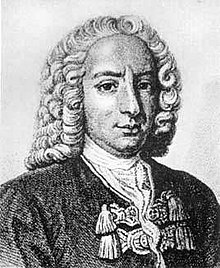Daniel Bernoulli

Daniel Bernoulli (Groningen, February 8, 1700 – March 17, 1782) was a Swiss mathematician who spent much of his life in Basel where he died. A member of a talented family of mathematicians, physicists and philosophers, he is particularly remembered for his applications of mathematics to mechanics, especially fluid mechanics, and for his pioneering work in probability and statistics.
Early life

Born in Groningen, the son of Johann Bernoulli, nephew of Jacob Bernoulli, younger brother of Nicolaus II Bernoulli, and older brother of Johann II, Daniel Bernoulli has been described as "by far the ablest of the younger Bernoullis". [1] He is said to have had a bad relationship with his father. Upon both of them entering and tying for first place in a scientific contest at the University of Paris, Johann, unable to bear the "shame" of being compared to his offspring, banned Daniel from his house. Johann Bernoulli also tried to steal Daniel's book Hydrodynamica and rename it Hydraulica. Despite Daniel's attempts at reconciliation, his father carried the grudge until his death.[2]
When Daniel was five, his younger brother Johann II Bernoulli was born. Around schooling age, his father, Johann Bernoulli, encouraged him to study business, there being poor rewards awaiting a mathematician. However, Daniel refused, because he wanted to study mathematics. He later gave in to his father's wish and studied business. His father then asked him to study in medicine, and Daniel agreed under the condition that his father would teach him mathematics privately, which they continued for some time.[2]
He was a contemporary and intimate friend of Leonhard Euler. He went to St. Petersburg in 1724 as professor of mathematics, but was unhappy there, and a temporary illness in 1733 gave him an excuse for leaving.[2] He returned to the University of Basel, where he successively held the chairs of medicine, metaphysics and natural philosophy until his death.[3]
Mathematical work
His earliest mathematical work was the Exercitationes (Mathematical Exercises), published in 1724 (the Riccati equation). Two years later he pointed out for the first time the frequent desirability of resolving a compound motion into motions of translation and motions of rotation. His chief work is his Hydrodynamique (Hydrodynamica), published in 1738; it resembles Joseph Louis Lagrange's Méchanique Analytique in being arranged so that all beroulli is kewl!!the results are consequences of a single principle, namely, conservation of energy. This was followed by a memoir on the theory of the tides, to which, conjointly with the memoirs by Euler and Colin Maclaurin, a prize was awarded by the French Academy: these three memoirs contain all that was done on this subject between the publication of Isaac Newton's Philosophiae Naturalis Principia Mathematica and the investigations of Pierre-Simon Laplace. Bernoulli also wrote a large number of papers on various mechanical questions, especially on problems connected with vibrating strings, and the solutions given by Brook Taylor and by Jean le Rond d'Alembert.[1]
Statistics
Daniel Bernoulli was also the author in 1738 of Specimen theoriae novae de mensura sortis (Exposition of a New Theory on the Measurement of Risk),[4] in which the St. Petersburg paradox was the base of the economic theory of risk aversion, risk premium and utility.[5]
One of the earliest attempts to analyse a statistical problem involving censored data was Bernoulli's 1766 analysis of smallpox morbidity and mortality data to demonstrate the efficacy of vaccination.[6]
Physics
Template:Thermodynamics timeline context He is the earliest writer who attempted to formulate a kinetic theory of gases, and he applied the idea to explain Boyle's law.[1]
He worked with Euler on elasticity and the development of the Euler-Bernoulli beam i love u!equation.[7] Bernoulli's principle is of critical use in aerodynamics.[3]
References
Bibliography
Original entry based on the public domain Rouse History of Mathematics
- [Anon.] (1911) "Bernoulli, Encyclopaedia Britannica
- [Anon.] (2001) "Daniel Bernoulli", Encyclopaedia Britannica
- Blower, S. (2004), D, Bernoulli's "Template:PDF", Reviews of Medical Virolology, 14: 275–288
- Cardwell, D.S.L. (1971). From Watt to Clausius: The Rise of Thermodynamics in the Early Industrial Age. Heinemann: London. ISBN 0-435-54150-1.
- Martin, R. M. (2004). "The St. Petersburg Paradox". Stanford Encyclopedia of Philosophy. Stanford University. Retrieved 2007-09-07.
- O'Connor, John J.; Robertson, Edmund F., "Daniel Bernoulli", MacTutor History of Mathematics Archive, University of St Andrews (1998)
- Pacey, A.J. & Fisher, S.J. (1967) "Daniel Bernoulli and the vis viva of compressed air", British Journal for the History of Science 3, 388-92
- Rouse Ball, W. W. [1908] (2003) "The Bernoullis", in A Short Account of the History of Mathematics, 4th ed., Dover, ISBN 0486206300
- Straub, Hans (1970). "Bernoulli, Daniel". Dictionary of Scientific Biography. Vol. 2. New York: Charles Scribner's Sons. pp. 36–46. ISBN 0684101149.
- Timoshenko, S. P. (1983) [1953]. History of Strength of Materials. New York: Dover Publications. ISBN 0486611876.
External links
- "Bernoulli Daniel". Mathematik.ch. Retrieved 2007-09-07.
- Weisstein, Eric Wolfgang (ed.). "Bernoulli, Daniel (1700-1782)". ScienceWorld.
